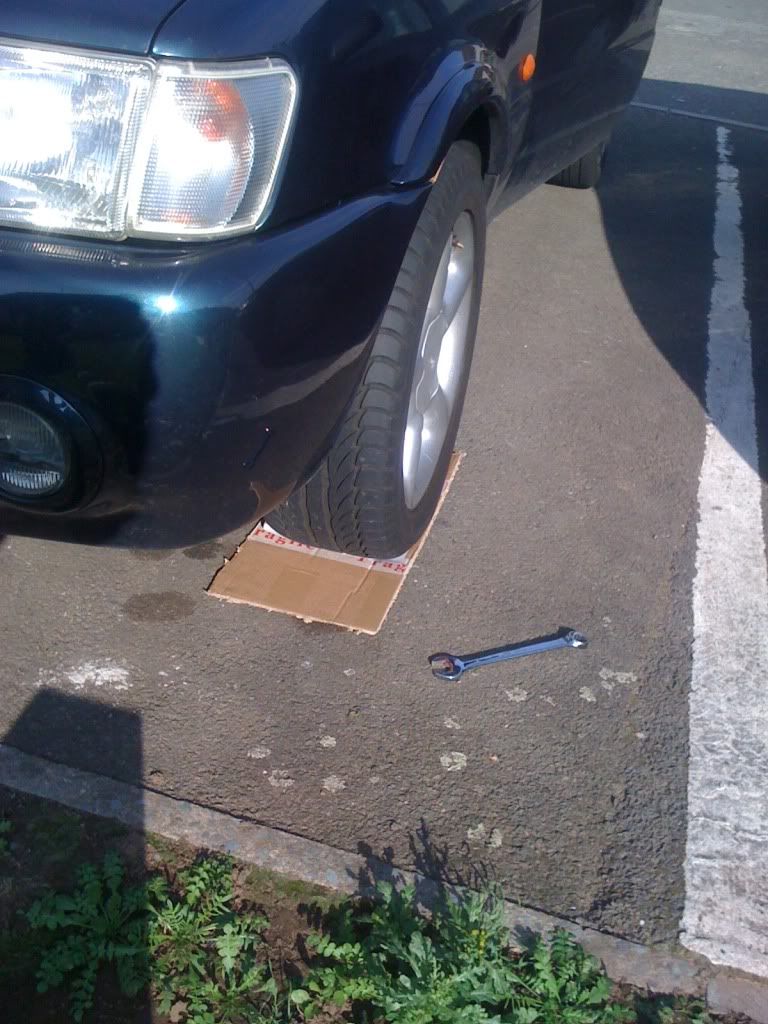Ooooooh! Pretty pictures! Haven't done these in a while, but took a few while I was doing the tracking. Had a second go at the tracking to improve it as it wasn't quite right still and I have a new and quite quick method now. I'll write it as a guide as that shows exactly what I did.
Firstly, doing the tracking yourself requires a flat surface for the car to be on however there's no such thing as flat in Derby, so I chose a slight slope and aimed for 1mm toe out max. The reason for this is when you edge a car forward up a slope (FWD anyway) the front wheels will pull the car forward and hence toe in compared to the normal setting. It isn't much but it's something to consider when doing the calculations.
To follow this guide you will need:
Two axle stands.
Sliding caliper ruler.
Whatever tools you need to remove the wheel caps.
Spanner sized for the tie rod end locking nut. (Fiesta MK3's are 19mm).
Mole grips.
Cloth.
Knife/scissors.
String.
Pen and Paper.
You will also need something to go under the front wheels to allow them to turn easily. I used two large pieces of cardboard and four sheets of magazine cover (mine here was the cover pages from F1 Racing magazine). All you need to do is break the friction between the road surface and the tyre. Place these just in front of the wheels and gently edge the car onto them, checking to see if they are correctly positioned as so:

Make sure the wheel is now centred and remove the keys to lock the wheel with the steering lock mechanism.
Next, take your axle stands and position them fore and aft of the wheels on one side. Measure the height of the centre of your wheel and find the best point to run the string on your stands. My wheel centre was about 28cm, and this pretty much lined up with the bolt hole on the axle stands. To make sure my tying didn't offset the string, I tied the string on one hole then passed it through the other side towards the other stand. Move the stands until they are starting to tip towards the other one and this should be nice and taught. Move them closer and get the string about an inch away from the wheel edges front and back, no need to be accurate, more adjustments coming.

Take the caps off the wheels. and get the sliding caliper tool out. I got mine from a pound shop (!) and it's the rod part we want to use as so:

Do this on both wheels, measuring both sides, then move the stands to equalise them out. Use dead reckoning, ie. aim for about 30mm on all measurements, the toe angles front and rear, along with the track distances will give plenty of room for 1-2mm error here, though the more accurate you make it the better. Once equalised you can now start measuring the front toe. Shake the car a little, bounce the wheel up and down to make sure first. Measure the foremost point on the wheel, and the rearmost:


Shake and bounce the car again, measure again. On the pen and paper I named the front edge A and the rear edge B. Add the two measurements together, as we did two measurement, the first front measurement is A1 and the second after the shake is A2, B is the same. Add them and divide by 2. We now have a more accurate number to work with.
Now A needs to equal B-3mm (+/-1.5mm). This is based off the official Ford figures for toe angle and converted for 15inch wheels, these figures would actually be in the acceptable range of all Fiesta models. However, if you did it on an up slope like I did, you will need to account for the pull on the toe when edging forward, which means you want to aim for a zero toe or a A = B-1mm amount. This is what I went for. My A was 15 and B was 21, a difference of 6mm after taking two measurements! Well outside the tolerances, but from what I did yesterday I knew this was an improvement!
Now, one turn on the tie rod equals an adjustment of 1mm (ISO thread measurements). You need to take your difference and divide by two. This is the number of turns you need. Get under the wheel, don't disturb the string, and loosen that tie rod end locking nut one more turn than what you need. Take some mole grips and the cloth and turn that tie rod. I needed 3 turns anti-clockwise to move the tie rod out of the tie rod end to adjust for 6mm difference. I wasn't going to mess about with half a turn to hit 1mm toe out. Preferably, use something on the tie rod to help count your turns, I use a zip tie. Adjust accordingly and then tighten the tie rod end locking nut. Shake and bounce the car and remeasure. Repeat until you're happy with the numbers.
Do the same for the other side.
Here's the maths:
A1 - 14
A2 - 16
B1 - 20
B2 - 21
A3= A1 + A2 / 2
B3 = B1 + B2 / 2
B3 - A3 = DIFFERENCE
If DIFFERENCE is positive, tie rod turns are anti-clockwise, else clockwise. TURNS = DIFFERENCE / 2
I am never going to pay someone to do my tracking ever again. I went for zero to 1mm toe out, drives perfectly now. Still a little ever so slight pull here and there, so I may retrack at some point and move it in a mm more.



